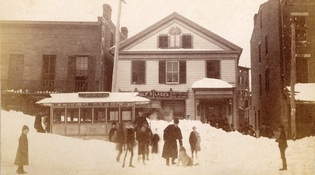 loading
loading
Old YaleFour feet underThe Blizzard of 1888. Judith Ann Schiff is chief archivist at the Yale University Library.  Manuscripts & ArchivesWhen the snow stopped falling, the best way to travel on Grand Avenue in New Haven was by foot. View full imageThe most famous snowstorm in American history, the Blizzard of ’88, struck the Yale campus in its full force on Monday and Tuesday, March 12 and 13, 1888. The "Great White Hurricane," which paralyzed the East Coast from the Chesapeake Bay to Maine, was unexpected and unpredicted. Spring had been in the air on the weekend of March 10, as the crew practiced in New Haven harbor, and Saturday events proceeded as usual. On Sunday, a gentle rain began. It turned to torrents as the day went on, and after midnight, the temperature plummeted, the wind speed rose to more than 50 miles per hour, and snow started to fall fast and thick. By Monday morning, communication with the outside world was impossible. The blizzard howled on until Tuesday noon. Connecticut and upstate New York had the heaviest snowfall; the deepest accumulation in New England was 50 inches, recorded in Middletown, some 25 miles northeast of New Haven. About 400 lives were lost on land and sea, including 200 deaths in New York City. But in New Haven, the blizzard for the most part caused only inconvenience. The published Yale memoirs of the storm are understated, often humorous. The 1888 Class Book, printed for graduation, recounts: "The blizzard of March 12 and 13 needs only to be mentioned to call up memories of struggles through the snow to boarding-houses, to find only condensed milk and cold meat awaiting one; but the pleasant memories of the train 'daisy' and the joys of four days free from recitations, made amends for the little discomforts that had to be endured." The 1889 Class Book notes, "Our faculty was found to be of sturdier stuff than we expected. Even the professor of Logic, although the logical conclusion that such a storm ought to stop recitations was evident to his pupils, did not miss an hour." Nevertheless, it took a week to restore routine train and horse-car service in the city, according to the Yale Daily News, which continued publication with a limited distribution. "Mammoth" drifts could be "seen almost anywhere." One student, Charles Francis Baldwin ’88, captured numerous snow scenes on glass plate negatives; his album is preserved in Sterling Library. Some of his photographs show the trains at the New Haven depot, where 175 passengers were stranded. ("A quartette of sophomores serenaded the snow-bound passengers at the depot Tuesday evening," reported the News.) On Wednesday at 12:45 pm, the first train pulled in, from Springfield. It had been on the tracks for 26 hours. Professors took advantage of the experience in their teaching. Economics professor Henry W. Farnam, in place of his Tuesday classes, gave Sheff seniors a lecture on the economic effects of the storm. The explorer and scientist William Henry Brewer gave lectures to Sheff juniors on glaciers, "illustrated by the stereopticon." Students unable to reach the campus were excused, but the students on campus found plenty of recreation. The News reported that two Sheffield men, on a bet, had climbed to the top of East Rock Monday night. By Thursday, the crew, preparing for the spring races, had already resumed rowing in the New Haven harbor. And on Friday the News reprinted a New Haven Register story on a snowball fight -- including the "exasperating" arrest of a Yale professor. The New Haven police, according to the report, had "varied the monotony of a snow-stalled life in New Haven" by arresting two "frolicsome, thoughtless" students for "firing snowballs" near the campus. Then, later in the day, "Professor Townsend was added to the list of miscreants who came within the clutches of the law." This Professor Townsend was probably William Kneeland Townsend ’71, ’74 LLB, ’78LLM, ’80DCL, a distinguished professor in the Law School and later a federal judge. "A sharp reprimand from an officer would have been sufficient to put an end to the snowballing," chided the Register. "We are glad to see our police force remain energetic and enterprising in spite of such little obstacles as a blizzard, but such exercise as they indulged in yesterday was not sensible." The Yale Record, the campus humor magazine, memorialized the blizzard in three cartoons. One of these, captioned "THE BLIZZARD (TING-A-LING-LING). THE WAY IT STRUCK US," was a full page of eight panels portraying a student making his way through the storm. In the first sketch, his umbrella is blowing inside out and his derby is being blown off his head; things go downhill from there, and in the final panel, student and hat have been buried in a snowdrift. Another cartoon retreads a perennial campus theme of the era, the male students' pursuit of visiting women. It showed a young lady, wearing a hat and supposedly bound for Florida, sitting in a snowbound train in New Haven. Outside her window was a group of hopeful Yale men. Finally, the Record gives us a glimpse of life after the snow started to melt. Its third cartoon was a navigational map of the area outside Lawrance Hall, showing areas of slush and mud with depth markings in each, "from soundings taken during the last thaw." There are depths of 3 feet, 19 feet, 35 feet, and "bottomless."
The comment period has expired.
|
|